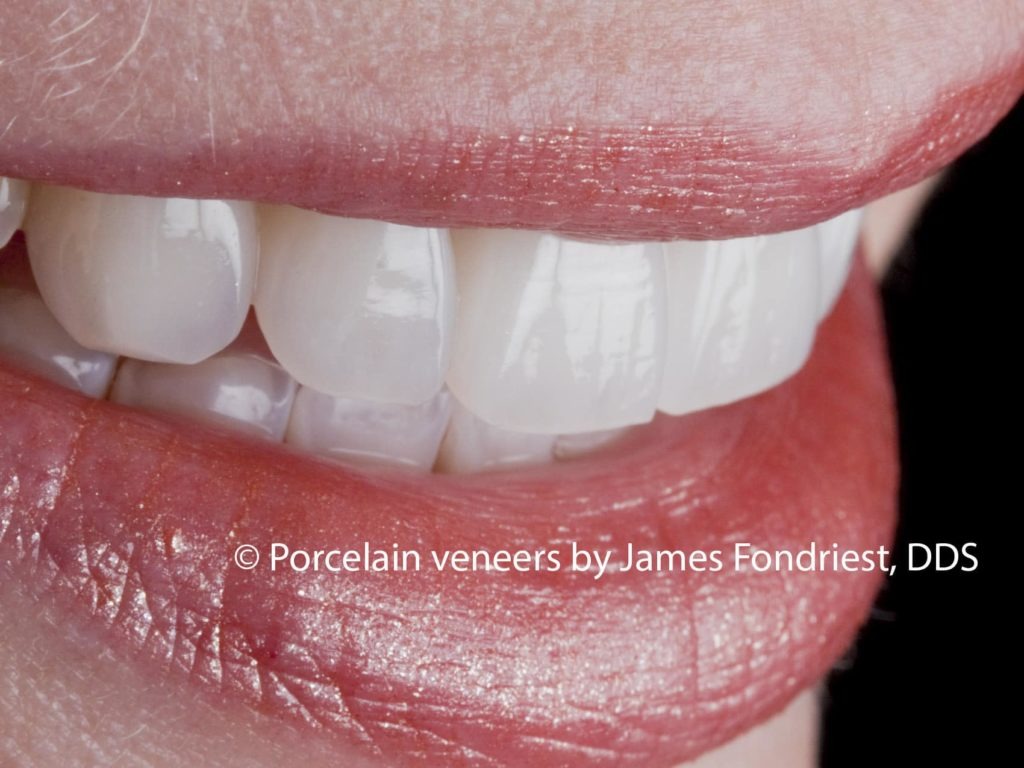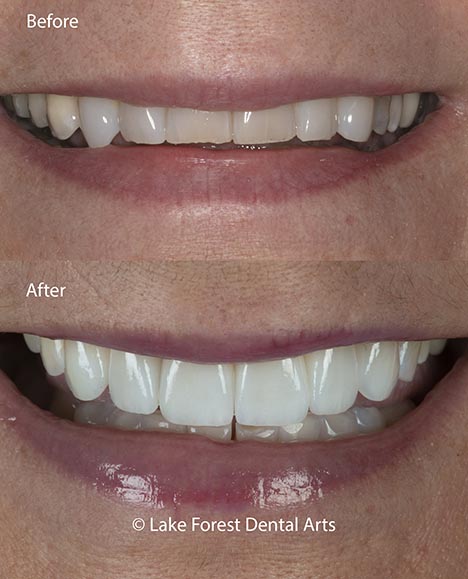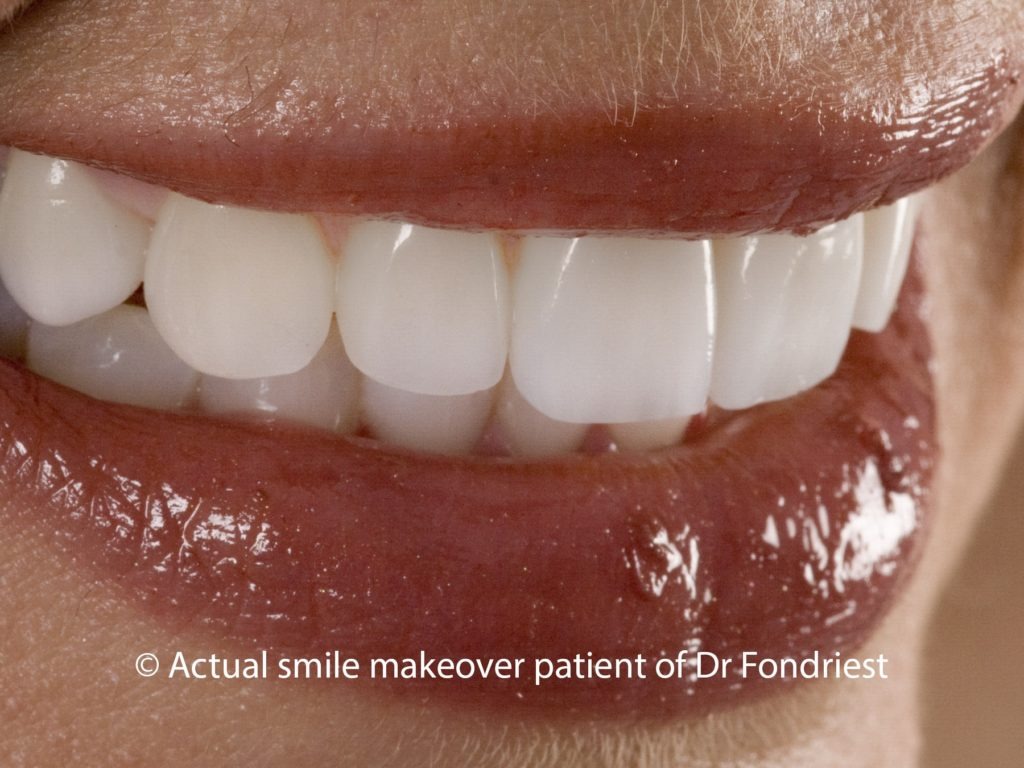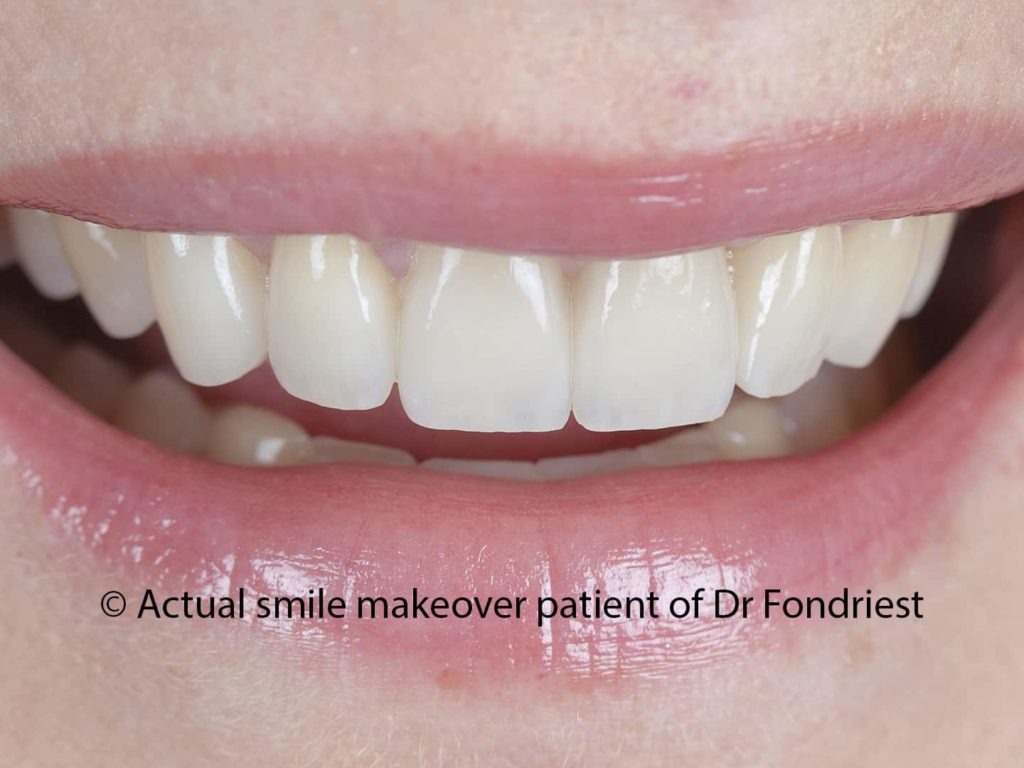What are porcelain veneers?
Porcelain veneers are thin custom made shells or jackets designed to cover the front tooth surface of a tooth. These bonded covers or laminates offer a durable way of creating or restoring beauty to a smile. They also can be used to re-establish function and strength.

This Winnetka patient had spaces or gaps in her smile. She wanted natural shading and surface textures so that no one could tell that she had her teeth done. Her treatment consisted of beautiful porcelain smile improvements.
These thin sheets of ceramic are becoming a very popular treatment choice for cosmetic dentists. They only cover the parts of the tooth that have been damaged or that require a change of shape or color. A porcelain veneer can be a far more conservative alternative to a dental crown. The more skilled dentists tend to remove less tooth structure.
Uses of porcelain veneers:
- Close spaces caused by gum disease, “black triangles” between teeth
- Correcting the length and width
- Tooth straightening without braces
- Restore tooth decay, erosion, attrition, fixing heavy wear
- To cover the screw hole on a dental implant crown or root canal
- Repair broken teeth, chips, or cracks
- Changing occlusion
- Brighten your smile and cover stained teeth
- Replace bonding with upgraded restorations
- Improve oral health by closing spaces and preventing food impaction
- Consistent color and stain resistant
- Create even tooth shapes
- Fix a chipped tooth, gapped teeth, diastemas
Characteristics of Porcelain Laminates

This television personality based in Chicago, IL wanted her teeth to show more in her smile. The goal of cosmetic dentistry is to make the dental work blend with natural teeth.
Laminates were originally developed as a way to save tooth structure while improving how the teeth look. These teeth covers can be as thin as 0.2mm. Often only a small amount of tooth reduction is needed.
Porcelain veneers always preserve more enamel than crowns. More structure is retained each time a tooth is fixed. The tooth will be stronger and able to be fixed again in the future.
The porcelain margin blends very nicely with the tooth. This blended margin avoids the dreaded “black line” commonly found on poorly done or old porcelain on metal crowns. These restorations are bonded to place and are far less likely to leak or fail.
These thin ceramic restorations can match the light transmitting properties of natural enamel. This allows our veneers to be invisible and “believably natural”.

Porcelain can be made so thin that it blends nicely with the natural tooth beneath it. This makes the margin invisible. A contact lens effect allows the margin to blend into the root.
How Are Porcelain Veneers Made
There are three steps to a veneering procedure:
1) Evaluation and planning between doctor and patient:
First, we ask you to share your goals and expectations with us. We will take photographs, models, and possibly x-rays to plan the steps to achieve the desired outcome. Sometimes other specialists (e.g. orthodontists, and gum specialists) are brought in to help achieve perfect symmetry in your smile.
A plan is settled and the exact length, shape, surface texture, shade, and position of every tooth is determined. The doctor and his lab technician partner will decide if any tooth structure needs to be removed.
2) Preparation of the mouth and impressions:

This Indiana physician wanted porcelain veneers. She preferred that we not drill on her real teeth. Her teeth had been dark due to using medicine as a teenager. Her local dentist said that he would have to do full crowns to cover the darkness. She did her research and came to us to be restored. We were able to be much more conservative with tooth reduction by doing low prep veneers. We chose a porcelain that was opaque enough to cover the stains but still beautiful.
The dentist prepares your teeth by removing a small amount of enamel. Laminates can be created with little drilling of tooth enamel. If aggressive changes in shape or position are desired drilling will be needed. Significant drilling will require temporary veneers to give you a nice interim smile.
Impressions of the teeth and supporting structures are taken and sent to the laboratory. Photographs, and measurements of the face, bite, and jaw movements are also sent. A detailed prescription is written by the doctor.
A complete summary of your dreams, desires, and expectations is sent to the dental laboratory. This informs the ceramist exactly what you want.
3) Delivery and bonding:
The dentist will confirm proper fit and appearance. The custom teeth covers are then bonded to the front of your tooth. The bonding agents are made of the same materials (composite) that tooth colored fillings are made from.
Satisfaction with the result is universally positive. You may need a short time to adapt phonetically if the tooth locations or lengths have been changed. This adaptation period varies from a few hours to several weeks.
How much do porcelain veneers cost?
Quality level of Ceramist influences Cost
Most ceramists are not certified dental technicians (CDTs). There are even fewer Master Ceramists (MDTs) who have years of training and developed talent.
As with every profession, there is a bell shaped curve of talent and outcome quality. The higher end dentists use the finest ceramists. The training level of the ceramist determines the quality of the veneer restorations.
The ceramist will charge the dentist directly anywhere from $25 to $1,200 for a single veneer. The restorative dentist then adds this lab fee to the overall cost to the patient. The veneer cost to the patient also ranges greatly from as low as $1600/veneer to $3500/veneer. It is common to have 6-12 veneers done at a time.
Are porcelain veneers strong?

Often night grinders have shortened or heavily worn teeth. There is an untrue belief (even by some dentists) that laminates can’t be done if you grind your teeth. Actually, porcelain veneers are an excellent choice for night grinders. Advances in ceramics have the newer porcelains matching the wear and fracture strength of natural enamel.
All types of veneers can be strong, but like many things in life, it depends. If the dentist has a light touch with the drill then the veneer will be incredibly strong. In fact, it will strengthen the tooth.
If no enamel remains a veneer may not be a strong option. When the vast majority of enamel has been removed, a crown is a better treatment choice.
Without enamel, the bond is weaker. The strength and longevity will be suspect. This is especially true with people who grind their teeth.
Due to the low tensile strength of glass, it is possible for veneers to chip at the edges when overloaded. As stated earlier, porcelain is about 90% the strength of natural enamel.
Porcelain can be bonded to teeth just like composite resin but is much stronger than composite veneers. The bond is very strong if the dentist follows all of the steps. Unfortunately, to lower costs, dentists will skip important steps if they take more time.
Long term care for your new smile
A smile makeover is properly cared for in the same way as natural teeth. Brushing and flossing your teeth and gums is just as important.
Drs. Fulreader and Fondriest are Nationally recognized and highly sought after cosmetic dentists serving clients from throughout the United States
